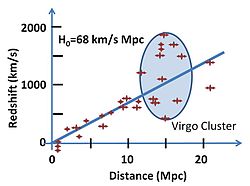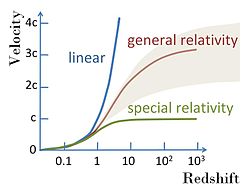Hubble's law

Hubble's law, or the Hubble–Lemaître law, is the name for an astronomical observation. The observation is that:
- All objects observed in deep space have a doppler shift-measured velocity relative to Earth, and to each other;
- That velocity is proportional to their distance from the Earth and all other interstellar bodies.
The space-time volume of the observable universe is expanding. Hubble's law is the direct physical observation of this.[1] This is why we believe the Universe is expanding. The evidence supports the Big Bang model.
Although widely attributed to Edwin Hubble, the law was first derived from the General Relativity equations by Georges Lemaître in a 1927 article. There he proposed that the Universe is expanding, and suggested a value for the rate of expansion, now called the Hubble constant.[2][3][4][5][6] Two years later Edwin Hubble confirmed the existence of that law and got a more accurate value for the constant that now bears his name.[7] The recession velocity of the objects was inferred from their redshifts, as measured earlier by Vesto Slipher in 1917 and related to velocity by him.[8]
Expression
The law is often expressed by the equation v = H0D, with H0 the constant of proportionality (the Hubble constant) between the "proper distance" D to a galaxy and its velocity v (see Uses of the proper distance). H0 is usually quoted in (km/s)/Mpc, which gives the speed in km/s of a galaxy 1 megaparsec (3.09×1019 km) away. The reciprocal of H0 is the Hubble time.
Estimation
A recent 2011 estimate of the Hubble constant, which used a new infrared camera on the Hubble Space Telescope (HST) to measure the distance and redshift for a collection of astronomical objects, gives a value of H0 = 73.8 ± 2.4 (km/s)/Mpc.[9][10] An alternate approach using data from galactic clusters gave a value of H0 = 67.0 ± 3.2 (km/s)/Mpc.[11][12]
A number of other methods have been used, giving figures between 70 and 72 (km/s)/Mpc. A recent (2016) method using the oldest light in the universe suggests the Hubble Constant value was 66.53km/s per megaparsec soon after the expansion began. This implies that the rate of expansion has been increasing.[13]
Rate of expansion
The expansion of the Universe is accelerating.[14][15][16] The accelerated expansion of the universe was discovered during 1998 by two independent projects. These were the Supernova Cosmology Project and the High-Z Supernova Search Team. They both used distant type 1a supernovae to measure the acceleration.[17][18][19]
More recent accounts
According to an article in New Scientist, there are two main ways of measuring this, and they do not agree.[20] The two methods used are:
Hubble's Law Media
An analogy for explaining Hubble's law, using raisins in a rising loaf of bread in place of galaxies. If a raisin is twice as far away from a place as another raisin, then the farther raisin would move away from that place twice as quickly.
Fit of redshift velocities to Hubble's law. Various estimates for the Hubble constant exist.
A variety of possible recessional velocity vs. redshift functions including the simple linear relation v = cz; a variety of possible shapes from theories related to general relativity; and a curve that does not permit speeds faster than light in accordance with special relativity. All curves are linear at low redshifts.
Related pages
References
- ↑ Peter Coles, ed. (2001). Routledge critical dictionary of the new cosmology. Routledge. p. 202. ISBN 0-203-16457-1.
- ↑ Lemaître, Georges (1927). "Un univers homogène de masse constante et de rayon croissant rendant compte de la vitesse radiale des nébuleuses extra-galactiques". Annales de la Société Scientifique de Bruxelles. A47: 49–56. Bibcode:1927ASSB...47...49L. (Full article, PDF). Partially translated (the translator remains unidentified) in Lemaître, Georges (1931). "Expansion of the universe, A homogeneous universe of constant mass and increasing radius accounting for the radial velocity of extra-galactic nebulæ". Monthly Notices of the Royal Astronomical Society. 91: 483–490. Bibcode:1931MNRAS..91..483L. doi:10.1093/mnras/91.5.483..
- ↑ Bergh, Sidney van den (6 June 2011). "The Curious Case of Lemaitre's Equation No. 24". Journal of the Royal Astronomical Society of Canada. 105 (4): 151. arXiv:1106.1195. Bibcode:2011JRASC.105..151V.
- ↑ Block, David L. (13 February 2019). "Georges Lemaître and Stigler's Law of Eponymy". Georges Lemaître: Life, Science and Legacy. Astrophysics and Space Science Library. Vol. 395. pp. 89–96. arXiv:1106.3928. doi:10.1007/978-3-642-32254-9_8. ISBN 978-3-642-32253-2. S2CID 119205665 – via arXiv.org.
- ↑ Reich, Eugenie Samuel (27 June 2011). "Edwin Hubble in translation trouble". Nature. doi:10.1038/news.2011.385 – via Crossref.
- ↑ Livio, Mario (2011). "Mystery of the missing text solved". Nature. 479 (7372): 171–173. Bibcode:2011Natur.479..171L. doi:10.1038/479171a. PMID 22071745. S2CID 203468083.
- ↑ Hubble, Edwin 1929. A relation between distance and radial velocity among extra-galactic nebulae Proceedings of the National Academy of Sciences of the United States of America. 15, 3, 168-173. (Full article Archived 2008-06-30 at the Wayback Machine, PDF)
- ↑ Malcolm S Longair (2006). The Cosmic Century. Cambridge University Press. p. 109. ISBN 0-521-47436-1.
- ↑ Riess, Adam G.; et al. (2011). "A 3% solution: determination of the Hubble constant with the Hubble Space Telescope and Wide Field Camera" (PDF). The Astrophysics Journal. 730 (2): 119. arXiv:1103.2976. Bibcode:2011ApJ...730..119R. doi:10.1088/0004-637X/730/2/119. S2CID 53531339.
- ↑ 'New study gives dark energy a boost' Archived 2012-09-30 at the Wayback Machine (Ron Cowen), Science News, 16 March 2011.
- ↑ Beutler, Florian; et al. (2011). "The 6dF Galaxy Survey: baryon acoustic oscillations and the local Hubble constant". Monthly Notices of the Royal Astronomical Society. 416 (4): 3017–3032. arXiv:1106.3366. Bibcode:2011MNRAS.416.3017B. doi:10.1111/j.1365-2966.2011.19250.x. S2CID 55926132.
- ↑ 'Hubble Constant: a new way to measure the expansion of the universe', Science Daily, 27 July 2011.
- ↑ Amos, Jonathan 2016. Hubble clocks faster cosmic expansion. BBC News Science & Environment. [1]
- ↑ Overbye, Dennis (20 February 2017). "Cosmos controversy: the Universe is expanding, but how fast?". The New York Times. https://www.nytimes.com/2017/02/20/science/hubble-constant-universe-expanding-speed.html. Retrieved 21 February 2017.
- ↑ Scharping, Nathaniel (18 October 2017). "Gravitational waves show how fast the Universe is expanding". Astronomy (magazine). Retrieved 18 October 2017.
- ↑ Weaver, Donna; Villard, Ray (11 March 2018). "Measuring universe expansion reveals mystery – Is something unpredicted going on in the depths of space?". Earth & Sky. Retrieved 11 March 2018.
- ↑ "Nobel physics prize honours accelerating universe find". BBC News. 2011-10-04. https://www.bbc.co.uk/news/science-environment-15165371.
- ↑ "The Nobel Prize in Physics 2011". Nobelprize.org. Retrieved 2011-10-06.
- ↑ Peebles, P.J.E.; Ratra, Bharat (2003). "The cosmological constant and dark energy". Reviews of Modern Physics. 75 (2): 559–606. arXiv:astro-ph/0207347. Bibcode:2003RvMP...75..559P. doi:10.1103/RevModPhys.75.559. S2CID 118961123.
- ↑ Arias, Maria 2022. Does the rate of expansion of the Universe bust our best cosmological model? New Scientist, 9 July 2022. Vol 255, issue 3394.





